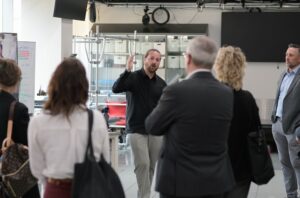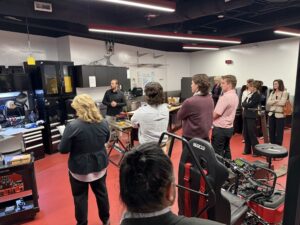
On April 15th, representatives from the offices of Senator Mike Lee, Senator John Curtis, Representative Celeste Maloy, Representative Blake D. Moore, and Governor Spencer Cox joined Assistant Professor Jacob A. George at the Craig H. Neilsen Rehabilitation Hospital at University of Utah Health for a tour of the Utah NeuroRobotics Laboratory.
There, they got a chance to shake hands with the LUKE Arm, the “neuroprosthesis” that is now ready for clinical trial participants to take home. Using a technology known as a direct neural interface, the NeuroRobotics lab is developing a way for patients to control a robotic limb through thought alone. The same technology also enables the prosthesis to send feedback to the brain, giving the user a new sense of touch.
George, the lab’s director, has appointments that span the John and Marcia Price College of Engineering and the Spencer Fox Eccles School of Medicine. That overlap, as well as his lab’s location in the Neilsen Rehabilitation Hospital, is emblematic of his work: using cutting-edge engineering technologies to improve the human experience.
Starting the tour in the hospital’s clinical space, George explained the hub-and-spoke model that connects patients — who may be recovering from a stroke, spinal cord injury, amputation, or other mobility issues — with researchers in the NeuroRobotics lab. Beyond traditional physical therapy, patients can also participate in join up with the lab’s more experimental approaches.
“In Utah, for example, we have a lot of people who get injured doing outdoor activities who want to continue doing those activities,” said George. “We’re designed to accommodate those interests and meet patients where they’re at.”

In that vein, George showed off the building’s “mobility garage,” which houses specially modified equipment designed to be used with joystick or mouth controls. The attached machine shop allows for customization work, both on the garage’s tetraski and sailboats, and on patients’ prosthetics and other mobility equipment. Those projects are part of TRAILS, Technology Recreation Access Independence Lifestyle Sports, University of Utah Health’s global adaptive program that focuses on the recreation, wellness and education needs of people with complex physical injury or illness.
In the building’s main experimental space, the Advanced Rehabilitation Technology Research Studio, George delved into the details of the direct neural interface technology. By implanting a Utah Slant Array into the nerves of a patient’s residual limb, the brain signals that would otherwise go to their missing hand can be digitally recorded. Using artificial intelligence, the researchers can develop a model of what physical motions those signals are intended to control. The direct neural interface then translates the brain signals into ones that manipulate the 12 degrees of freedom within the LUKE Arm.
Critically, these signals can be used to control any external device; the NeuroRobotics lab is building an open source API that users can further customize.
“We’re tapping into the brain’s native communication language and we’re sending signals as fast the body can,” said George. “That’s the idea behind ‘BIOS’ — instead of a computer’s basic input/output system, it’s a biological input/output system.”
A new contract with startup Biologic Input Output Systems (BIOS) will support the University of Utah’s ongoing Investigational Device Exception Early Feasibility Study, allowing for the recruitment of its clinical trial’s next participant.
George also serves as Chief Scientist for BIOS. In 2022, BIOS executed a licensing agreement with the University of Utah for the technology behind the direct neural interface, and continues to evolve the technology towards commercialization.
George was joined by BIOS Chief Development Officer Timothy Miller, who explained the trajectory the direct nerve interface technology was on to becoming commercially viable.
“Commercial prosthetic arms are becoming more realistic but there’s still no intuitive way of controlling them,” says Miller. “We like to say that companies like DEKA are building the Ferraris of prosthetics, but BIOS is making the gasoline.”
BIOS is working alongside the Utah NeuroRobotics Lab, University of Utah Health, the Craig H. Neilsen Rehabilitation Hospital and Mayo Clinic to close the gap between patients and innovation by making the direct nerve interface technology commercially available. The BIOS direct nerve interface was granted a “Breakthrough Device Designation” from the federal Food and Drug Administration (FDA) in March 2024, as well as admission into its Total Product Lifecycle Advisory Program. The FDA uses these programs to fast-track promising experimental medical devices toward everyday use.
“The unmet medical need for upper limb loss is huge,” said George. “Upwards of 50% of upper-limb prosthetic users eventually put them on the shelf because they just don’t work well enough. It’s what we call ‘learned non-use.’ But working in Nielsen means we have a golden window for getting this technology to patients immediately after their injury so they can incorporate it into their daily lives.”